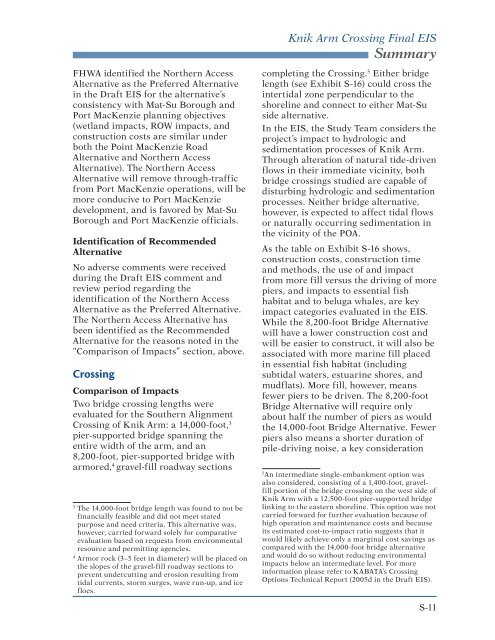FEIS Summary - Knik Arm Bridge and Toll Authority
FEIS Summary - Knik Arm Bridge and Toll Authority
FEIS Summary - Knik Arm Bridge and Toll Authority
You also want an ePaper? Increase the reach of your titles
YUMPU automatically turns print PDFs into web optimized ePapers that Google loves.
<strong>Knik</strong> <strong>Arm</strong> Crossing Final EIS<br />
<strong>Summary</strong><br />
FHWA identified the Northern Access<br />
Alternative as the Preferred Alternative<br />
in the Draft EIS for the alternative’s<br />
consistency with Mat-Su Borough <strong>and</strong><br />
Port MacKenzie planning objectives<br />
(wetl<strong>and</strong> impacts, ROW impacts, <strong>and</strong><br />
construction costs are similar under<br />
both the Point MacKenzie Road<br />
Alternative <strong>and</strong> Northern Access<br />
Alternative). The Northern Access<br />
Alternative will remove through-traffic<br />
from Port MacKenzie operations, will be<br />
more conducive to Port MacKenzie<br />
development, <strong>and</strong> is favored by Mat-Su<br />
Borough <strong>and</strong> Port MacKenzie officials.<br />
Identification of Recommended<br />
Alternative<br />
No adverse comments were received<br />
during the Draft EIS comment <strong>and</strong><br />
review period regarding the<br />
identification of the Northern Access<br />
Alternative as the Preferred Alternative.<br />
The Northern Access Alternative has<br />
been identified as the Recommended<br />
Alternative for the reasons noted in the<br />
“Comparison of Impacts” section, above.<br />
Crossing<br />
Comparison of Impacts<br />
Two bridge crossing lengths were<br />
evaluated for the Southern Alignment<br />
Crossing of <strong>Knik</strong> <strong>Arm</strong>: a 14,000-foot, 3<br />
pier-supported bridge spanning the<br />
entire width of the arm, <strong>and</strong> an<br />
8,200‐foot, pier-supported bridge with<br />
armored, 4 gravel-fill roadway sections<br />
3<br />
The 14,000-foot bridge length was found to not be<br />
financially feasible <strong>and</strong> did not meet stated<br />
purpose <strong>and</strong> need criteria. This alternative was,<br />
however, carried forward solely for comparative<br />
evaluation based on requests from environmental<br />
resource <strong>and</strong> permitting agencies.<br />
4<br />
<strong>Arm</strong>or rock (3–5 feet in diameter) will be placed on<br />
the slopes of the gravel-fill roadway sections to<br />
prevent undercutting <strong>and</strong> erosion resulting from<br />
tidal currents, storm surges, wave run-up, <strong>and</strong> ice<br />
floes.<br />
completing the Crossing. 5 Either bridge<br />
length (see Exhibit S-16) could cross the<br />
intertidal zone perpendicular to the<br />
shoreline <strong>and</strong> connect to either Mat-Su<br />
side alternative.<br />
In the EIS, the Study Team considers the<br />
project’s impact to hydrologic <strong>and</strong><br />
sedimentation processes of <strong>Knik</strong> <strong>Arm</strong>.<br />
Through alteration of natural tide-driven<br />
flows in their immediate vicinity, both<br />
bridge crossings studied are capable of<br />
disturbing hydrologic <strong>and</strong> sedimentation<br />
processes. Neither bridge alternative,<br />
however, is expected to affect tidal flows<br />
or naturally occurring sedimentation in<br />
the vicinity of the POA.<br />
As the table on Exhibit S-16 shows,<br />
construction costs, construction time<br />
<strong>and</strong> methods, the use of <strong>and</strong> impact<br />
from more fill versus the driving of more<br />
piers, <strong>and</strong> impacts to essential fish<br />
habitat <strong>and</strong> to beluga whales, are key<br />
impact categories evaluated in the EIS.<br />
While the 8,200-foot <strong>Bridge</strong> Alternative<br />
will have a lower construction cost <strong>and</strong><br />
will be easier to construct, it will also be<br />
associated with more marine fill placed<br />
in essential fish habitat (including<br />
subtidal waters, estuarine shores, <strong>and</strong><br />
mudflats). More fill, however, means<br />
fewer piers to be driven. The 8,200-foot<br />
<strong>Bridge</strong> Alternative will require only<br />
about half the number of piers as would<br />
the 14,000-foot <strong>Bridge</strong> Alternative. Fewer<br />
piers also means a shorter duration of<br />
pile-driving noise, a key consideration<br />
5<br />
An intermediate single-embankment option was<br />
also considered, consisting of a 1,400-foot, gravelfill<br />
portion of the bridge crossing on the west side of<br />
<strong>Knik</strong> <strong>Arm</strong> with a 12,500-foot pier-supported bridge<br />
linking to the eastern shoreline. This option was not<br />
carried forward for further evaluation because of<br />
high operation <strong>and</strong> maintenance costs <strong>and</strong> because<br />
its estimated cost-to-impact ratio suggests that it<br />
would likely achieve only a marginal cost savings as<br />
compared with the 14,000-foot bridge alternative<br />
<strong>and</strong> would do so without reducing environmental<br />
impacts below an intermediate level. For more<br />
information please refer to KABATA’s Crossing<br />
Options Technical Report (2005d in the Draft EIS).<br />
S-11
















